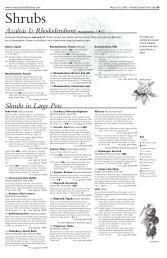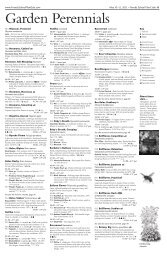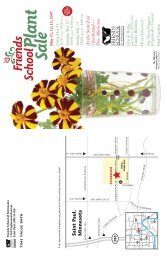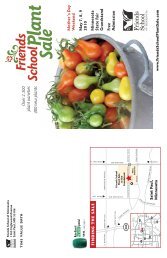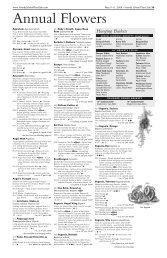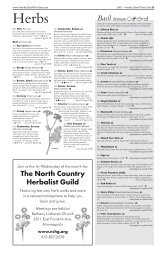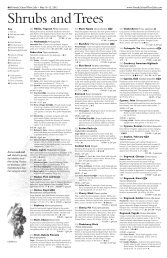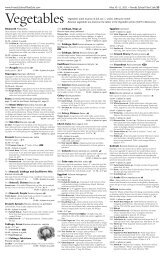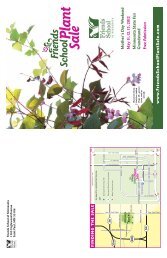2005 Catalog (PDF: 2.9MB) - Friends School Plant Sale
2005 Catalog (PDF: 2.9MB) - Friends School Plant Sale
2005 Catalog (PDF: 2.9MB) - Friends School Plant Sale
You also want an ePaper? Increase the reach of your titles
YUMPU automatically turns print PDFs into web optimized ePapers that Google loves.
<strong>2005</strong> • <strong>Friends</strong> <strong>School</strong> <strong>Plant</strong> <strong>Sale</strong> 21<br />
Minding the Monarchs<br />
Citizen scientists document monarch population patterns in gardens, prairies and parks<br />
BY KAREN OBERHAUSER<br />
Did you know that the first monarch<br />
butterfly found in Mexican overwintering<br />
colonies had been tagged by<br />
Minnesota volunteer citizen scientists? Until the<br />
time in 1975 when Chaska’s Jim Gilbert and his<br />
students tagged that first butterfly, the colonies<br />
had been unknown to the scientific community.<br />
This find was the culmination of more than 20<br />
years of tagging efforts, started by Dr. Fred<br />
Urquhart at the University of Minnesota,<br />
intended to track the monarchs’ movements.<br />
Current monarch citizen science projects are<br />
building a treasure trove of long-term data that<br />
will help us better understand monarch and<br />
insect ecology. You can join the hundreds of<br />
Minnesotans who volunteer to help increase our<br />
understanding of potential impacts of global climate<br />
change, pollution, habitat destruction and<br />
other factors on monarchs—and, perhaps, information<br />
to identify habitats of special importance<br />
to monarchs.<br />
Monarch Basics<br />
Minnesota monarchs breed in an area from the<br />
southern U.S. to southern Canada and from the<br />
Atlantic Seaboard to the Rocky Mountains. This<br />
range is limited by the monarch’s milkweed<br />
host plants. Each spring, the monarchs return<br />
to the southern U.S. from overwintering sites<br />
in central Mexico and lay eggs in the southern<br />
U.S. That same spring and summer, more generations<br />
recolonize the rest of the summer<br />
breeding range, with variation each year in their<br />
arrival at different northern locations.<br />
Monarchs appear to vacate the southern U.S.<br />
for much of the summer, probably due to high<br />
temperatures and host plant die-back.<br />
Monarchs have five instars (the caterpillar<br />
stages between molts). At spring temperatures in<br />
the Twin Cities, development can require more<br />
than 60 days, compared to fewer than 30 days in<br />
summer. This timing allows three generations in<br />
the northern part of their range, in addition to<br />
the generation that begins in the southern U.S.<br />
Milkweed Is Key<br />
Volunteer citizen scientists in the Monarch<br />
Larva Monitoring Project (MLMP), part of the<br />
Monarchs in the Classroom program at the<br />
University of Minnesota, collect monarch population<br />
data at a range of times and places. All an<br />
MLMP volunteer needs is access to a site containing<br />
milkweed and willingness to monitor<br />
the site on a weekly basis during the summer!<br />
The number of milkweed plants, site size and<br />
type, and site location vary greatly; sites include<br />
small backyard gardens, railroad right-of-ways,<br />
abandoned fields and pastures, and restored<br />
prairies. Since some volunteers don’t have individual<br />
access to sites or may not want to commit<br />
to weekly monitoring, many nature centers<br />
organize monitoring teams at their centers.<br />
Volunteers thus have ready-made sites and a<br />
larger research team to share their workload.<br />
Once a season, volunteers describe their sites,<br />
recording their location, size, and the milkweed<br />
species that grow on the site. They estimate perplant<br />
monarch densities on a weekly basis, by<br />
either examining all of the milkweed plants for<br />
eggs and larvae (in smaller sites) or sampling a<br />
randomly chosen subset of plants. They record<br />
the number of eggs and each type of larva found<br />
and the number of plants examined.<br />
MLMP Volunteers<br />
More than 500 students, teachers, naturalists,<br />
scientists, retirees, and others have participated<br />
in the MLMP. Together, they have monitored<br />
Above left: a royal visit to a St. Paul garden. Above right: Monarch caterpillars shed their skin five<br />
times between hatching from their egg and becoming a chrysalis, or pupa. The intervals between<br />
shedding this skin are called “instars;” all five instars (and an egg) are shown in this photo.<br />
Below: It takes two generations of monarchs to make the return trip from Mexico to their northern<br />
breeding range each summer.<br />
I’m one of those environmentalists who looks for<br />
opportunities to “walk the talk,” so becoming<br />
involved in citizen science projects just comes<br />
naturally. And since I’m also active in turning<br />
my yard from urban monoculture into a diverse<br />
native habitat, the monarchs add color,<br />
pollination and life to my wild mix.<br />
Neighbors see me going about the data collection<br />
in my yard and sometimes stop to inquire—<br />
a chance to hook them on nature. If I can reach<br />
someone else, maybe just one more person will<br />
make a difference in this fragile planet.<br />
—AN MLMP VOLUNTEER<br />
sites in 29 states and two Canadian provinces.<br />
Whether they work in a classroom or not, many<br />
MLMP volunteers become teachers through<br />
their participation in the project.<br />
Project Findings<br />
MLMP volunteers are helping to answer key<br />
questions about monarch biology:<br />
• How do monarch populations change<br />
throughout the spring, summer and fall in<br />
different parts of North America?<br />
• When does most mortality occur?<br />
• What plant qualities affect female choice of<br />
plants for egg laying?<br />
• What kinds of habitat are best for monarchs?<br />
Together, this team of citizen scientists has<br />
helped to document distinct generations of<br />
monarchs. They’ve learned, in contrast to the<br />
“common wisdom,” that monarchs leave the<br />
northern parts of their summer breeding range<br />
and migrate to overwintering sites in central<br />
Mexico, that many monarchs stop in Texas for<br />
another round of egg production. Scientists at<br />
the University of Minnesota are currently trying<br />
to learn whether this fall behavior represents an<br />
early response to a warming climate.<br />
Citizen scientists have also found that life for<br />
young monarchs is hard; only five to ten percent<br />
survive to become the beautiful orange and<br />
black butterflies that grace our gardens and<br />
prairies.<br />
On an even more alarming note, volunteers<br />
have documented a steady decrease in monarch<br />
numbers over the past three summers. This pattern<br />
will lead to scientific research to point us to<br />
the cause, and thus, hopefully to changes in<br />
human behavior that may help to preserve this<br />
beautiful butterfly.<br />
Be a Citizen Scientist with MLMP<br />
The dedication of over 500 volunteers has been<br />
the foundation of this research. If you would<br />
like to join this intrepid group, visit the MLMP<br />
website at www.mlmp.org to learn more, or<br />
contact Karen Oberhauser at the U of M<br />
(oberh001@umn.edu) or an MLMP trainer at<br />
one of the Minnesota sites below. We promise<br />
that you’ll put your garden to good use!<br />
Karen Oberhauser is a member of the Department of<br />
Fisheries, Wildlife and Conservation Biology,<br />
University of Minnesota. The MLMP is funded by the<br />
National Science Foundation.<br />
Twin Cities-Area MLMP Trainers<br />
Bell Museum Don Luce lucex001@umn.edu<br />
New London Becky West 320-354-5373<br />
Laura Molenaar laura@mlmp.org<br />
Eastman Nature Center Vicky Wachtler<br />
vwachtler@threeriversparkdistrict.org<br />
<strong>Friends</strong> of Lilydale Park Grit Youngquist<br />
grit.youngquist@co.ramsey.mn.us<br />
Westwood Hills Nature Center Kerry Wilcox<br />
kwilcox@stlouispark.org<br />
Lowry Nature Center Mary Vanderford<br />
mvanderford@threeriversparkdistrict.org<br />
Tamarack Nature Center Anna Newton<br />
anna.newton@co.ramsey.mn.us<br />
Milkweeds at the <strong>Plant</strong> <strong>Sale</strong><br />
Asclepias is the Latin name for the milkweed family.<br />
Members of the family in the plant sale include:<br />
• Natives—A. tuberosa Butterfly Weed, A. incarnata<br />
Swamp Milkweed, A. speciosa Showy Milkweed, and<br />
A. exaltata Poke Milkweed<br />
• Annuals—Asclepias curassivica Butterfly Flower<br />
• Perennials—A. tuberosa and A. incarnata Butterfly<br />
Weed.






